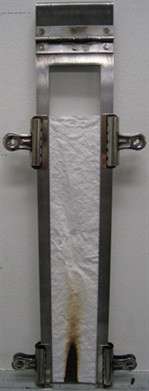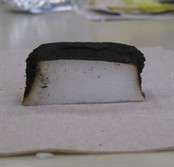Thin polymer coating used to create fire-resistant fabrics

Dr. Jaime Grunlan's research into fire-resistant materials is featured in the September 2012 issue of Smithsonian magazine.
The article, "How Biomimicry is Inspiring Human Innovation," highlights Grunlan's development of a thin polymer coating that keeps cotton clothing and polyurethane-foam-based furniture from going up in flames.
Grunlan, an associate professor in the Department of Mechanical Engineering, works with polymer nanocomposites that have properties similar to those of metals and ceramics—conducting electricity, for instance—while maintaining properties of polymers, such as low density.
"We can now make cotton fabric that doesn't burn at all,"Grunlan says.

Grunlan's technology involves covering every microscopic fiber in a fabric with a thin composite coating of two polymers that exhibit an intumescent effect, producing a protective carbon foam coating when exposed to high temperatures.
The thin films are about one-tenth of a micron thick, or about one-thousandth the thickness of a human hair, and are created with the layer-by-layer assembly technique in which the coating is deposited onto the surface of the fiber being coated. This layer-by-layer process allows Grunlan to control the thickness of the coating down to the nanometer level.
Grunlan says the technology will be suitable for clothing, including children's clothing; lab coats; and medical clothing for both doctors and patients. It can even be used in military camps, where a fire in a single tent can wipe out an entire camp.
But the technology's applications go far beyond just clothing and fabric. The coating could be used in foams, such as those found in sofas, mattresses, theater and auditorium seats, airplane seat cushions, and building insulation.
On polyurethane foam, a coating of chitosan (a natural material extracted from shrimp and lobster shells) and clay is deposited to eliminate melt dripping during burning. The nanocomposite mixture coats the interior walls of foam. The result is that when burned, the treated foam keeps its shape instead of puddling at high temperatures like untreated polyurethane foam does. This quality eliminates the "melt-dripping" effect that further spreads fires.
"It's like we're building a nano-brick wall within each cell of the foam," Grunlan says.
That brick wall keeps the foam from being destroyed. And the coating is so thin that it adds only 4 to 5 weight-percent to the foam and does not negatively alter its color, texture or flexibility.
Provided by Texas A&M University

















